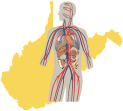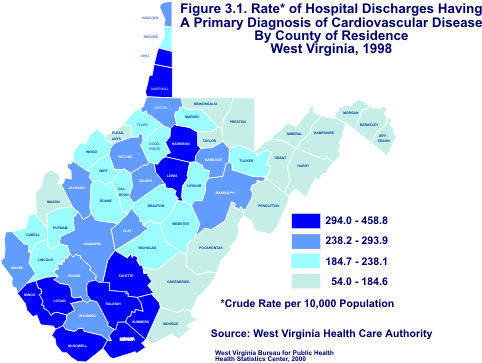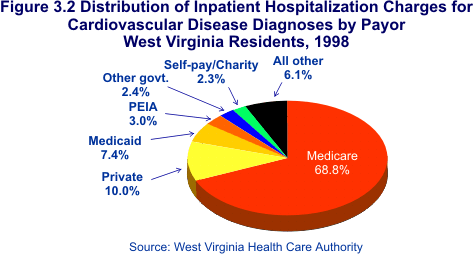The Burden of Cardiovascular Disease in West Virginia
Credits
Summary
Chapter 1
Chapter 2
Chapter 3
Chapter 4
Chapter 5
Chapter 6
References
Appendix A
Appendix B
Appendix C
Appendix D

Chapter Three
The Economic Costs of Cardiovascular Disease
Personal HC Expenditures | Discharges | Charges
The American Heart Association estimates the economic costs of cardiovascular disease in the United States in 2001 at $298.2 billion (2). This includes health expenditures (the direct costs incurred by CVD – services provided by doctors and other health professionals, hospital and nursing home costs, medications, home health expenses, and other medical durables), estimated at $182 billion, and lost productivity from CVD morbidity and mortality (the indirect costs of the disease), estimated at $116 billion. The costs of the suffering caused by CVD and the loss of life are impossible to assess. The impact of CVD on the nation is so immense that everyone is affected, not only in terms of higher health care costs but through lost uses of our tax dollars that must go to care for Medicare and Medicaid recipients. The aging of the baby boomers will only worsen an already staggering financial burden.
Return to topPersonal Health Care Expenditures. A study conducted by Hodgson and Cohen and published in Medical Care in October 1999 (31) estimated national 1995 personal health expenditures for selected circulatory diseases using data provided by the Health Care Financing Administration (HCFA). The Health Statistics Center, Office of Epidemiology and Health Promotion, Bureau for Public Health, applied the methodology used by Hodgson and Cohen to estimate West Virginia's 1995 personal health care expenditures for cardiovascular disease. State estimates for total personal health care costs are published on the HCFA web site9. The Center used these estimates and applied the proportions attributed to cardiovascular disease by Hodgson and Cohen in their national study to estimate state expenditures. The results are shown in Table 3.1. Because West Virginia has an older population and a traditionally higher rate of CVD illness among its residents, these estimates are conservative.
HCFA estimated 1995 personal health care expenditures attributable to cardiovascular disease in West Virginia at $683,000,000, or 12.7% of the state's total estimated cost of personal health care of $5,373,000,000. As used here, personal health care expenditures include hospital care, physician and other professional services, home health care, prescription drugs, vision products, and other medical durables, and nursing home care10. Of the nearly $700 million, $543,000 000 was attributed to heart disease and $140,000,000 to stroke.
Hospital care represented the largest proportion of personal health care expenditures attributed to cardiovascular disease (59.3%), followed by nursing home care (17.3%). Per care category, however, cardiovascular disease accounted for the greatest share of total nursing home care expenditures at 27.6%. Eighteen percent (17.9%) of home health care costs in 1995 were attributed to cardiovascular disease.
Figure 3.1 Pop-up table of estimated amount of personal health care expenditures for cardiovascular disease in West Virginia for 1995.
Hospital Discharges. In 1998, there were a total of 229,226 inpatient hospital discharges of West Virginia residents from West Virginia hospitals. Over eight out of every ten, or 191,046, had a cardiovascular disease diagnosis as any one of the first eight diagnoses on the discharge record. Heart disease was listed as any of the first eight diagnoses on 172,668 (75.3%) discharges; it was the primary diagnosis on 35,082 (15.3%). In the U.S. as a whole, 13.6% of all hospitalizations in 1998 listed heart disease as the primary diagnosis. There were 18,378 (8.0%) discharges of residents from West Virginia hospitals on which cerebrovascular disease was noted as any of the first eight diagnoses; of these, 7,900 (3.4%) listed stroke as the primary diagnosis. Nationally, 3.2% of all hospital discharges listed stroke as the primary diagnosis.
CVD-Related Hospital Discharge Rates. Table 3.2 presents West Virginia and United States hospital discharge rates for cardiovascular disease for 1998 by gender and age. The overall rate of hospitalizations of West Virginia residents having a primary cardiovascular disease diagnosis was 238.1 per 10,000 population; the comparable national rate was 195.7 per 10,000 population. The rate of heart disease as a primary diagnosis in West Virginia resident hospitalizations was 22.4% higher than the comparable U.S. rate, 194.3 versus 158.7 discharges per 10,000 population. There was an 18.4% higher rate of discharges with a primary diagnosis of stroke, 43.8 versus 37.0.
By gender, both men and women in West Virginia had higher rates of heart disease and stroke hospitalizations in 1998 than their national counterparts. By age group, higher rates of heart disease hospitalizations occurred in West Virginia than the U.S. among persons aged 45-64, while higher rates of stroke hospitalizations were reported in the state among those aged 65 and older.
County CVD-Related Hospital Discharge Rates. The overall rates of hospital discharge records having a primary diagnosis of cardiovascular disease in 1998 ranged from a high of 458.8 per 10,000 population among Lewis County residents to a low of 54.0 among residents of Hampshire County. Figure 3.1 illustrates CVD-related hospital discharge rates by county. Lewis County residents had the highest rates of both primary heart disease and stroke diagnoses, 378.7 and 80.1, respectively. Hampshire County residents had rates of 46.8 for heart disease hospitalizations and 7.2 for stroke hospitalizations. Individual county rates for both primary and secondary diagnoses of heart disease and stroke are included in Appendix B, as well as county rankings.
Average Length of Stay for CVD-Related Discharges. The overall average length of stay (ALOS) for West Virginians who were inpatients in West Virginia hospitals in 1998 was 5.5 days, compared to 5.1 days in the U.S. as a whole. For heart disease as a primary diagnosis, the ALOS was 5.5 days; for stroke, the ALOS was 7.3 days. The comparable U.S. figures were lower for both diagnoses: 4.9 days for heart disease and 5.9 days for stroke.
Return to topCVD-Related Hospital Charges. Over one-quarter (25.7%) of all charges billed by West Virginia hospitals in 1998 were for hospitalizations having cardiovascular disease as the primary diagnosis. Of the total of nearly $2 billion charged by hospitals to all payors in 1998, approximately $470 million was for CVD-related diagnoses, i.e., either heart disease or stroke. Sixty-nine percent (68.8%) of CVD-related charges were billed to Medicare, with 10.0% billed to private insurers and 7.4% to Medicaid. Figure 3.2 illustrates the breakdown of total CVD-related charges by payor.
Figure 3.2 Pop-up table of Number and Rate of inpatient hospital discharge records having cardiovascular disease at the primary diagnosis.


Table 3.3 presents CVD-related diagnoses as a percentage of individual payor charges for 1998. Of the more than $1 billion billed to Medicare by West Virginia hospitals in that year, approximately 31% of that amount, or $324 million, was for hospitalizations having CVD listed as the primary diagnosis. Twenty-seven percent (27.0%) of charges billed to PEIA were CVD related. Medicaid had the smallest percentage of billed charges for hospitalizations that resulted in a CVD diagnosis at 13.7%.
Figure 3.3 Pop-up table of inpatient hospitalization charges for cardiovascular disease by payor in West Virginia for 1998.
The average length of stay (ALOS) for cardiovascular disease hospitalizations by payor is presented in Table 3.4. The longest ALOS for heart disease hospitalizations, 5.9 days, was billed to Medicare; the shortest ALOS, 4.1 days, was found among self-pay and charity patients. The ALOS for stroke hospitalizations was by far longest among Medicaid patients at 14.6 days. In contrast, PEIA recipients with a stroke diagnosis were hospitalized for an average of only 5.1 days.
Figure 3.4 Pop-up table of the number of hospital discharges and average length of stay for discharges having cardiovascular disease as the primary diagnosis, by payor, in West Virginia in 1998.
Footnotes
9 hwww.hcfa.gov/stats/nhe-oact/statestimates/Tables98/ - Return to text
10The total personal health care expenditures estimate provided by HCFA for West Virginia included the categories of dental services, drugs and other medical nondurables, and other personal health care in addition to those listed here and in Table 3.1. These categories were excluded from the present analysis in order to utilize the Hodgson and Cohen model. - Return to text